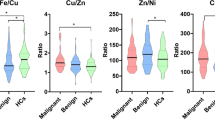Abstract
The objective of this study was to determine which elements in serum best differentiated breast cancer in a case-control study. Concentrations of 13 elements in serum of 68 breast tumor patients (25 malignant and 43 benign) and 26 healthy controls were measured. Logistic regression with different variable-selection procedures was used to determine a possible configuration of elements. Sensitivity and specificity of the model were calculated to obtain the optimal cutoff point for discriminating malignant breast cancers vs other individuals (including benign breast disease and normal ones). A combination of Cd, Mn, and Fe was found to have a specificity and sensitivity of 100% using forward-type logistic regression, when the cutoff value of the combination score was 52.71. Using stepwise-type logistic regression, a combination of Cr and Mn had a sensitivity of 100% and a specificity of 97.1% when the combination score of 17.4 was chosen as the cutoff. Similar analysis could be implemented to compare the malignant and control groups. Specificity and sensitivity were 100% for Mn (forward and stepwise type) with a cutoff point of 6.40. For the backward regression, specificity was 84.6% and sensitivity was 100% for Zn, with a cutoff point of 869.1. In conclusion, there was a significant difference in concentrations of all 13 elements in serum between breast cancer patients and controls. A combination among Cd, Mn, Fe, Cr, and Zn might be important to determine a differentiating reference for breast cancers if a long-term followed-up study is to be conducted.
Similar content being viewed by others
References
K. Geraki, M. J. Farquharson, D. A. Bradley, and R. P. Hugtenburg, A synchrotron XRF study on trace elements and potassium in breast tissue, Nucl. Instrum. Methods Phys. Res. B 213, 564–568 (2004)
F. Cavallo, M. Gerber, E. Marubini, et al., Zinc and copper in breast cancer, Cancer 67 735–745 (1991).
S. K. Gupta, V. K. Shukla, M. P. Vaidya, S. K. Roy, and S. Gupta, Serum trace elements and Cu/Zn ratio in breast cancer patients, J. Surg. Oncol. 46, 178–181 (1991).
K. Geraki and M. J. Farquharson, An X-ray fluorescence system for measuring trace element concentrations in breast tissue, Radiat. Phys. Chem. 61, 603–605 (2001).
H. Zhai, X. Chen and Z. Hu, Study on the relationship between intake of trace elements and breast cancer mortality with chemometric methods, Comput. Biol. Chem. 27, 581–586 (2003).
G. N. Schrauzer, D. A. White, and C. J. Schneider, Cancer mortality correlation studies. III. Associations with dietary selenium intakes, Bioinorg. Chem. 7, 23–34 (1977).
G. N. Schrauzer, D. A. White, and C. J. Schneider, Cancer mortality correlation studies. IV. Associations with dietary intakes and blood levels of certain trace elements, notably Se-antagonists, Bioinorg. Chem. 7, 35–56 (1977).
G. N. Schrauzer, Selenium: mechanistic aspects of anticarcinogenic action, Biol. Trace Element Res. 33, 51–62 (1992).
Sh.-Y. Yu, Y. J. Zhu, and W. G. Li, Protective role of selenium against hepatitis B virus and primary liver cancer in Qidong, Biol. Trace Element Res. 56, 117–124 (1997).
G. N. Schrauzer, Anticarcinogenic effects of selenium, Cell Mol. Life Sci. 57, 1864–1873 (2000).
M. K. Ng, D. A. Bradley, L. M. Looi, C. S. Mahmood, and A. K. Wood, Differentiation of elemental composition of normal and malignant breast tissue by instrumental neutron activation analysis, Appl. Radiat. Isot. 44, 511–519 (1993).
E. N. Drake II, and H. H. Sky-peck, Discriminant analysis of trace element distribution in normal and malignant human tissues, Cancer Res. 49, 4210–4215 (1989).
S. J. Press and S. Wilson, Choosing between logistic regression and discriminant analysis, J. Am. Statist. Assoc. 73, 699–705 (1978).
J. B. Copas and P. Corbett, Overestimation of the receiver operating characteristic curve for logistic regression, Biometrika 89, 315–331 (2002).
V. Singh and A. N. Garg, Trace element correlations in the blood of Indian women with breast cancer, Biol. Trance Element Res. 64, 237–245 (1998).
L. Piccinini, P. Borella, A. Bargellini, C. I. Medici, and A. Zoboli, A case-control study on selenium, zinc, and copper in plasma and hair of subjects affected by breast and lung cancer, Biol Trace Element Res. 51, 23–30 (1996).
I. Yucel, F. Arpaci, A. Ozet, et al., Serum copper and zinc levels and copper/zinc ration in patients with breast cancer, Biol. Trace Element Res. 40, 31–38 (1994).
W. C. Hawkes, D. S. Kelley, and P. C. Taylor, The effects of dietary selenium on the immunity system in healthy men, Biol. Trace Element Res. 81, 1–25 (2001).
G. N. Schrauzer, T. Molenaar, S. Mead, and K. Kuehn, Selenium in the blood of Japanese and American women with and without breast cancer and ibrocystic disease., Jpn. J. Cancer Res. (Gann) 76, 374–377 (1985).
M. P. Waalkes, S. Rehm, C. W. Riggs, et al., Cadmium carcinogenesis in male Wister [Crl:(WI)BR] rats: dose-response analysis of tumor induction in the prostate and testes and at the injection site, Cancer Res. 48, 4656–4663 (1988).
E. Antila, H. Mussalo-Rauhamaa, M. Kantola, F. Atroshi, and T. Westermarck, Assoication of cadmium with human breast cancer, Sci. Total Environ., 186, 251–256 (1996).
R. M. Leach, Role of managanese in mocopolysaccharide metabolism, Fed. Proc. 30, 991–994 (1971).
I. L. Mulay, R. Roy, B. E. Knox, N. H. Suhr, and W. E. Delaney, Trace metal analysis of cancerous and non-cancerous human tissues, J. Natl. Cancer Inst. 47, 1–13 (1971).
A. E. Schwartz, G. W. Leddicotlo, R. W. Fink, and E. W. Friedman, Trace elements in normal and malignant human breast tissue, Surgery 76, 325–329 (1974).
Author information
Authors and Affiliations
Rights and permissions
About this article
Cite this article
Wu, HD.I., Chou, SY., Chen, DR. et al. Differentiation of serum levels of trace elements in normal and malignant breast patients. Biol Trace Elem Res 113, 9–18 (2006). https://doi.org/10.1385/BTER:113:1:19
Received:
Revised:
Accepted:
Issue Date:
DOI: https://doi.org/10.1385/BTER:113:1:19




